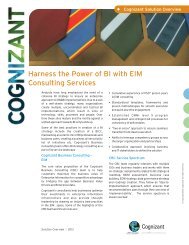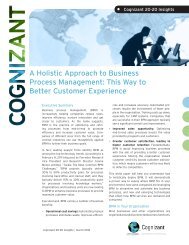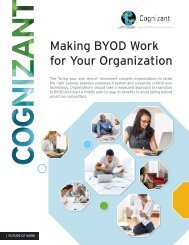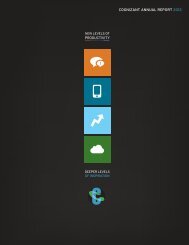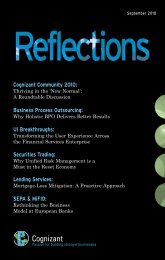Segment-Based Strategies for Mobile Banking - Cognizant
Segment-Based Strategies for Mobile Banking - Cognizant
Segment-Based Strategies for Mobile Banking - Cognizant
Create successful ePaper yourself
Turn your PDF publications into a flip-book with our unique Google optimized e-Paper software.
Executive Summary<strong>Mobile</strong> devices, including smartphones and tablets, have trans<strong>for</strong>medthe world in which we live. As digital channels evolve,the move to mobility continues to provide a faster and moreconvenient way <strong>for</strong> consumers to interact with their financialservices providers. Retail banking is no exception. Retail bankshave universally accepted mobile banking as a mainstreambanking channel rather than just an optional “add-on” service.However, to fully realize its potential, banks need to understandconsumer preferences regarding desired features andovercome barriers to wider adoption.Most retail banks have evolved their mobile strategies and,by extension, their customers’ mobile journey througha “one-size-fits-all” approach focusing on features andofferings. Given the rapid evolution of mobile technologyand its impact on banking, we conducted a study of mobilebanking by surveying customers across a wide array of retailbanks, age groups and income categories. The objective wasto understand emerging trends, as well as current and futureneeds, in order to help retail banks increase the adoption ofmobile banking services. Not surprisingly, our research revealsthat consumer expectations of mobile banking vary across ageand income groups.Just as retail banks segment consumers to improve theirproduct cross-selling and customer-acquisition ef<strong>for</strong>ts, theycan now apply similar tactics to their mobile strategies. Thishas major implications <strong>for</strong> banks in terms of where to investscarce development and financial resources. Retail banksmust also consider which consumer segments they wishto appeal to through their mobile offerings in order tooptimize customer retention and acquisition, and advance2 FUTURE OF WORK June 2013
service adoption. This represents an opportunity <strong>for</strong> retailbanks to continue to invest strategically in mobile technologiesand at the same time drive market differentiation.Key FindingsOur research indicates that retail banks need to take intoaccount a number of important factors when developing theirmobile initiatives:<strong>Segment</strong>ed experiences based on feature sets and userencounters greatly matter to younger consumers —something retail banks need to consider as they evolvetheir offerings to drive adoption and move to advanceddigital wallet strategies.Security perceptions of mobile banking remain a majorobstacle <strong>for</strong> consumer adoption, particularly amongolder demographic segments. In our view, this represents asignificant opportunity <strong>for</strong> banks to improve adoption.<strong>Mobile</strong> payments are a key area of opportunity <strong>for</strong> banks —compelling them to focus on better understanding customerneeds and monitor the technology landscape, which remainsfragmented due to multiple plat<strong>for</strong>ms and standards.Tablet computing has rapidly grown as a key engagementplat<strong>for</strong>m that is distinct from smartphones and PCs, andcan be employed to gain competitive advantage.Digital wallet capabilities offered through banks are ofgrowing interest to consumers, since they trust more intheir financial institution to provide feature-led innovationssuch as targeted offers designed to improve their increasinglymobile lifestyle. This represents a new opportunity <strong>for</strong>retail banks to serve their customers, attract new businessand generate more revenue.SEGMENT-BASED STRATEGIES FOR MOBILE BANKING 3
<strong>Mobile</strong> <strong>Banking</strong> Adoption Among Various Age Groups and Income Levels25-3450%55%59%74%73%86%18-2446%64%55%70%56%33%35-4430%47%59%55%64%46%Age45-5437%41%42%43%50%41%55-7027%39%37%19%27%41%8%Above 7025% 10%13%5%11%Less than $30,000 $30,000 to $49,999 $50,000 to $74,999$75,000 to $99,999 $100,000 to $149,999 $150,000+Response base: 2,143Figure 5<strong>Mobile</strong> banking services are accessed predominantly through mobile phones andtablets; 24% of respondents use both (see Figure 7). A growing number of consumersare using both smartphones and tablets as their primary Web-connected device(versus laptops or desktops).Consumers tend to prefer smartphone apps over mobile banking Web sites toaccess their accounts. A small percentage of consumers prefer text banking (seeFigure 8) — typically an older segment (see Figure 9).<strong>Mobile</strong> <strong>Banking</strong> Adoption Among Consumer <strong>Segment</strong>s74%58%57%39%Response base: 555Figure 6Aspiring Bloomers Ardent Affluents Liberal Users Cautious SeniorsDevices Used <strong>for</strong> <strong>Mobile</strong> <strong>Banking</strong>32%<strong>Mobile</strong>24%7%TabletResponse base: 706Figure 7SEGMENT-BASED STRATEGIES FOR MOBILE BANKING 7
Preferred <strong>Mobile</strong> <strong>Banking</strong> Mode64%57%12%Response base: 706Figure 8Smartphone app <strong>Mobile</strong> banking Web site SMS/Text bankingPreferred Mode <strong>for</strong> <strong>Mobile</strong> <strong>Banking</strong> by <strong>Segment</strong>Smartphone app57%41%68%64%73%76%<strong>Mobile</strong> banking Web site55%61%55%55%63%44%SMS/Text banking12% 20%24%Responde base: 706Figure 918-24 25-34 35-44 45-54 55-70 Above 70Core <strong>Mobile</strong> <strong>Banking</strong> Feature Usage andPersonalizationHaving a core set of mobile banking features is important if banks are to remaincompetitive and lay the foundation <strong>for</strong> more advanced mobile strategies thatappeal to consumers. Our research shows that the most popular core mobile bankingfeatures are related to in<strong>for</strong>mation search and payments (see Figure 10).The top features that consumers seek are account balances/loan balances tracking,transaction history and transferring funds between existing accounts. 1 This findingis not surprising, and indicates that basic functions are a commodity with virtuallyall banks offering core capabilities.The Top Three Features of <strong>Mobile</strong> <strong>Banking</strong>Account balances/Loan balances32%Transaction history16%Funds transfer betweenexisting accounts13%Remote check deposit10%Account alerts9%<strong>Mobile</strong> photo bill pay5%Response base: 706Figure 108 FUTURE OF WORK June 2013
Features Considered When Choosing or Switching BanksRemote check deposit22%Real-time alerts onunusual account activity20%Making payments usingsmartphones16%Response base: 706Figure 11There is a strong need to better understand the underlying drivers <strong>for</strong> choosing orswitching banks. While the top three features noted in Figure 10 are common acrossvirtually all banks, consumers are looking <strong>for</strong> greater functionality as they seekmore options. This strongly correlates with segmentation of consumer interest andbehavior. Interest in remote check deposit and real-time alerts on unusual accountactivity are important features that could induce consumers to switch banks (seeFigure 11). <strong>Mobile</strong> chat customer support is another desired feature <strong>for</strong> ArdentAffluents and Aspiring Bloomers.Remote deposit capture (RDC) is the feature most desired by Aspiring Bloomersand Ardent Affluents. Real-time alerts on unusual account activity is the featuremost desired by Liberal Users and Cautious Seniors — rein<strong>for</strong>cing that security is acritical concern to these segments in further adopting mobile banking services (seeFigure 12). It is important <strong>for</strong> banks to promote security features and create valuepropositions that emphasize security. Otherwise, they run the risk of losing clients.Feature personalization is important to more than 75% of the consumers surveyed.One-half of these respondents indicated they want the flexibility to personalize theirMost Desired <strong>Mobile</strong> <strong>Banking</strong> Features by <strong>Segment</strong>AspiringBloomersRemote check depositReward points just like indebit/credit card usageReal-time alerts onunusual account activity11%10%16%N=59ArdentAffluentsRemote check depositReal-time alerts onunusual account activityMaking payments usingsmartphones8%11%14%N=51LiberalUsersReal-time alerts onunusual account activityRemote check depositMaking payments usingsmartphones10%12%14%N=122CautiousSeniorsReal-time alerts onunusual account activityRemote check depositMaking payments usingsmartphones10%13%18%N=64Response base: 296Figure 12SEGMENT-BASED STRATEGIES FOR MOBILE BANKING 9
Importance of Feature PersonalizationImportance of personalization31% 46% 15% 9%Response base: 706Figure 13Highly important Important Somewhat important Not importantRanking Personalization FeaturesRearranging tabs and functionswithin the mobile app52%Date/Time <strong>for</strong>matThemes (color, image, etc.)Amount <strong>for</strong>matPreferred language45%44%43%42%Response base: 706Figure 14experience through features such as rearranging tabs and functions within themobile application (see Figures 13 and 14). Af<strong>for</strong>ding this flexibility by giving userscontrol over their experience is a differentiating tactic banks should consider. Webelieve this capability can help these retail banks more effectively retain customers.Enhanced Security: Key to <strong>Mobile</strong> <strong>Banking</strong> SuccessNot that long ago, consumers had to visit a branch to conduct basic bankingtransactions. Not anymore. With the introduction of online banking and now withmobile services, banking can happen anywhere, any time and on the go. However,security concerns surrounding mobile banking transactions remain a barrier toadoption, especially in key demographics. This challenge can become an opportunity<strong>for</strong> banks to provide enhanced security capabilities and educate consumers onexisting security features and protections.This is important, given that 71% of survey respondents rate security features“highly important” in choosing or switching banks (see Figure 15).Among mobile banking consumers, 70% of respondents believe security is amajor concern. In fact, 32% of non-mobile banking users cite security as the mostimportant concern when considering mobile banking adoption (see Figure 16).Importance of Security Features <strong>for</strong> Choosing or Switching BanksImportance of security features71% 23%4%2%Figure 15Highly important Important Somewhat important Not important10 FUTURE OF WORK June 2013
Security Concerns Among <strong>Mobile</strong> and Non-<strong>Mobile</strong> <strong>Banking</strong> Customers<strong>Mobile</strong> banking consumersNon-<strong>Mobile</strong> banking consumersSecurity of mobile transactions70% is a major concern among32%banking consumers.Response base: 2,143Figure 16Roughly 90% of respondents indicated they enter a user name/password combination <strong>for</strong> authentication to access their mobilebanking app. Knowledge-based answers and visual keys, typicallyfound in Web-based authentication options, have made their wayinto many retail banks’ mobile banking security protocols. Manybanks use a combination of all three <strong>for</strong> their mobile bankingservices (see Figure 17). A few retail banks offer mobile-friendlyPIN entry <strong>for</strong> authentication rather than more arduous, complexpassword-entry methods.In our experience, security represents an opportunity <strong>for</strong> retailbanks to improve both their underlying authentication technologyand the user experience, and convey stronger messages toconsumers on safety and security. This balanced approach canhelp differentiate market offerings, create a more positive viewof a bank’s mobile offering and broaden the appeal to multipleconsumer segments as they evaluate their primary bankingrelationship.In our experience,security represents anopportunity <strong>for</strong> retailbanks to improve boththeir underlyingauthentication technologyand the user experience,and convey strongermessages to consumerson safety and security.Secure <strong>Mobile</strong> App <strong>Banking</strong> Authentication FeaturesUser name and Password90%Question and Answer53%PIN/PIC code51%Response base: 706Figure 17The Importance of Biometric Security <strong>for</strong> Choosing or Switching BanksNo3% 29%Yes35% 33%Response base: 706Figure 18Willing to pay nominal fee <strong>for</strong> additional biomeric security featuresNot willing to pay nominal fee <strong>for</strong> additional biomeric security featuresSEGMENT-BASED STRATEGIES FOR MOBILE BANKING 11
Preferred Biometric Authentication MethodsFingerprint matching56% 53% 52% 69%Voice recognition22% 20% 22% 16%Facial recognition20% 25% 23% 14%Aspiring Bloomers Ardent Affluents Liberal Users Cautious SeniorsResponse base: 706Figure 19Consumer concerns over security are reflected in their choice of biometricfeatures: 68% of survey respondents indicated they believe biometric securityfeatures are important, while 35% noted that they are willing to pay <strong>for</strong> such afeature (see Figure 18).Fingerprint matching is the overwhelming favorite <strong>for</strong> biometric authentication(see Figure 19). The continuing evolution of mobile hardware to support this type offeature will no doubt further increase demand.Another security-related feature is consumers’ desire to receive mobile alertsabout suspicious transactions, in addition to notifications on normal transactionsand balances (see Figure 20). This represents a key area that banks can explore todeliver high-engagement mobile banking solutions. Customers appreciate real-timenotifications of their money and bank-account status, since these directly supportstheir desire to both actively manage and maintain control of their financial life.Consumer demand to receive these types of alerts is prevalent across all incomesegments. Implementing sophisticated alerting capabilities beyond notifications,such as interactive and actionable alert management, can increase consumerengagement and build their trust in their retail bank.A notification via text alerts is the most preferred method (see Figure 21, nextpage), with 53% of consumers choosing this method.Rating <strong>Mobile</strong> <strong>Banking</strong> Alert FeaturesAlerts on suspicious transactions29%29%28%29%Alerts on transactions (checkingaccounts, credit cards, debit, bill pay)26%27%25%26%Balance alerts(low balance/high balance)24%24%24%25%Password change orcontact in<strong>for</strong>mation change23%24%23%23%Alerts on payment due(loan/credit card)22%24%23%23%Alerts on investments14%18%17%17%Response base: 706Figure 20Less than $50,000 $50,000 to $74,999 $75,000 to $99,999 Above $100,00012 FUTURE OF WORK June 2013
Preferred AlertsNotify via msg inmobile app/Web siteNotify via pushnotificationNotify viavoice callNotifyvia e-mailNotifyvia SMSOverall4%3% 4%4%2%Overall7%7%5%6%11%Overall10%11% 12%8% 10%Overall25%28% 23%27%23%Overall53%50% 54%56% 54%Response base: 706Figure 21LeastPreferred$100,000Preferred Notification MethodMostPreferred<strong>Mobile</strong> Payments Progression<strong>Mobile</strong> technology is developing at a rapid pace, with significant and continuousinnovation creating numerous strategic options. As a result, mobile payment capabilityhas emerged as an important feature <strong>for</strong> consumers. Among consumers whouse mobile payments, 44% of those surveyed do so at least once a week. Approximately20% of those who use mobile payments do not want to pay a transactionfee (see Figure 22). Paying bills and transferring funds to another account are thetwo most important transaction types (see Figure 23).Frequency of <strong>Mobile</strong> Payment Service Use vs. Willingness to Pay Transaction FeesHigh frequency users6% 4% 5% 6% 4% 20%Moderate users2% 2%1% 10%Low frequency users5%$0.05 $0.10 $0.15 $0.25 $0.50 Zero/NoneResponse base: 706Figure 22Payments on <strong>Mobile</strong> PhonesResponse base: 706Figure 23Paid billsFunds transfer to another bank account/credit card/other accountsWaved or tapped mobile phone at thepoint of sale to pay <strong>for</strong> a purchaseUsed mobile wallet services19% 12% 15% 22%12% 9% 13% 19%4% 3% 5% 5%2%3% 3% 4%Less than $50,000 $50,000 to $74,999 $75,000 to $99,999 Above $100,000SEGMENT-BASED STRATEGIES FOR MOBILE BANKING 13
Transaction Fees <strong>for</strong> <strong>Mobile</strong> Payments9% 11%Overall 49%10%10%9%$0.05$0.10$0.15$0.25$0.5049% of mobile bankingconsumers are willing to pay<strong>for</strong> mobile payment services.Response base: 481Figure 24Overall, 49% of respondents said they are willing to pay <strong>for</strong> mobile paymentservices. In fact, 9% of respondents said they are willing to pay 50 cents <strong>for</strong> eachtransaction (see Figure 24).Payment Options <strong>for</strong> <strong>Mobile</strong> Phone TransactionsPayPal is by far the most used payment option <strong>for</strong> transactions. Bank paymentchannels and Visa/MasterCard wallet are the second and third favorite options,respectively (see Figure 25).PayPalBank payment channelVisa/MasterCard WalletGoogle WalletCarrier billingApple PassbookWallet services offered by other playersIsis (Verizon, AT&T and T-<strong>Mobile</strong> USA)Response base: 481Figure 251%2%7% 7% 10% 12%8% 7% 9% 9%4% 4% 5%3%4%15% 13% 14% 22%Less than $50,000 $50,000 to $74,999 $75,000 to $99,999 Above $100,000PayPal is also a dominant service <strong>for</strong> non-bank mobile consumer payments. Thesecond option, the bank payment channel, is used 28% less than PayPal. Also, ifa consumer has been using PayPal <strong>for</strong> some time, they are relatively loyal to likeservices unless a compelling alternative can be provided. Our research indicatesthat banks are in a position to attract some of these transactions by leveragingmobile banking offerings and mobile wallet applications that provide additionalDeterrents to <strong>Mobile</strong> Payment Usage3%Lower transactionfee <strong>for</strong> otherpayment optionsLow priorityLack of rewardpoints/coupons10% 12%Failure/interruptedtransactions whilemaking paymentsLack ofknowledge21% 39%Unsafe to storebank/card in<strong>for</strong>mationon mobile phoneSecurity of themobile transactions48% 54%Prefer otherpayment optionssuch ascredit/debit cardsHigh priorityResponse base: 706Figure 2614 FUTURE OF WORK June 2013
services, such as person-to-person (P2P) payments. Retail bankswould be wise to educate consumers about digital wallets andthe benefits they can provide. Given the trust many consumersplace in their retail banks, banks can gain mobile-paymentsmarket share by leveraging customers’ growing attachment totheir mobile banking applications. Still, consumers continue toprefer traditional payment options such as credit and debit cardsover mobile payment services, partly due to a lack of educationaround these services and the perceived lack of security of mobiletransactions (see Figure 26, previous page).Tablet <strong>Banking</strong>: A Distinct <strong>Mobile</strong>ExperienceTablets are quickly emerging as a unique user interface that isdistinct from both PCs and smartphones. The preference <strong>for</strong>tablets among consumers is clear: 41% of survey respondentswant to use tablets compared with smartphones (see Figure 27).Among tablet owners, 60% prefer to use their tablet <strong>for</strong> mobilebanking (see Figure 28). The preferences are more pronouncedamong affluent consumers. It’s important <strong>for</strong> banks to understand that consumersare now using both devices <strong>for</strong> different purposes. Smartphones are generallyalways with consumers, and the immediacy of in<strong>for</strong>mation and response oraction drives continual use. There<strong>for</strong>e, features should be optimized to suit thedevice’s <strong>for</strong>m factor. Tablets, which are rapidly replacing PCs/laptops <strong>for</strong> in-homecomputing, provide a <strong>for</strong>m factor <strong>for</strong> more detailed sharing of in<strong>for</strong>mation, butusage appears to be less transaction-driven.Tablets present an opportunity <strong>for</strong> banks to provide more detailed in<strong>for</strong>mationthat ties to cross-selling and relationship-building. Due to the growth in tabletcomputing, we see this as a unique opportunity that banks can further exploit.Savvy banks can leverage the ongoing growth of tablet computing to differentiatetheir offerings in the market.Our research indicatesthat banks are in aposition to attract someof these transactions byleveraging mobile bankingofferings and mobilewallet applications thatprovide additionalservices, such as personto-personpayments.Preference <strong>for</strong> Tablets vs. SmartphonesPrefer to use tablet8%9%11%13%Prefer to use smartphone8%4%9%11%Response base: 706Figure 27Less than $50,000 $50,000 to $74,999 $75,000 to $99,999 Above $100,000Preference <strong>for</strong> Tablet <strong>Banking</strong> Among Tablet Device OwnersPrefer to use tablet10%12%17%21%Do not prefer to use tablet8%5%11%16%Response base: 367Figure 28Less than $50,000 $50,000 to $74,999 $75,000 to $99,999 Above $100,000SEGMENT-BASED STRATEGIES FOR MOBILE BANKING 15
Top Features Preferred: Tablets vs. SmartphonesDepositing a check by taking a picture(remote check deposit)Real-time alerts on unusual account activityPaying bills by taking picture of paper bill(mobile photo bill pay)Making payments to my credit card bill(credit card payments)Integrated view of multiple accounts onsingle screen (credit card, checking account)Making payments using smartphones(mobile wallet services)Tracking investments and expenses(personal financial management tools)Person-to-person payments3%3%3%3%4%4%4%6%Percentages are weighted average of responses of the top three ranked features.Response base: 706Figure 29Remote check deposit, real-time alerts, mobile photo bill pay and credit cardpayments are the top features respondents seek when accessing banking serviceson their tablets (see Figure 29). These innovations are important <strong>for</strong> banks,considering that some of these services have only been commonly available inthe market within the past year. As previously illustrated in certain segments, lackof mobile innovation exposes banks to more risk of customer attrition. Our researchreveals that continuous innovation is very important to three key segments:Aspiring Bloomers, Ardent Affluents and Liberal Users.Ardent Affluents prefer an integrated view of multiple accounts on a single screen(see Figure 30). They rate it second in importance after remote check deposit.This user experience can be best delivered on a tablet versus a smartphone. Thisconfirms that the digital channel includes the multiple device types and <strong>for</strong>mfactors (e.g. smartphones, tablets, phablets and PCs) consumers expect theirexperience to accommodate, regardless of the device they use to connect with thebank at any given time.Feature-Driven Innovations and Offers Open DigitalWallet OpportunitiesAs banks consider offering digital wallet options, they should take into account thetrust and interest consumers place in their mobile banking relationship. Althoughthere are multiple definitions of a digital wallet, our analysis indicates that retailTop Tablet Features Preferred by Ardent AffluentsDepositing a check by taking a pictureTapping/waving the smartphone tomake paymentsTracking investments and expensesTapping/waving the smartphone tomake payments5%5%5%5%Response base: 46Figure 3016 FUTURE OF WORK June 2013
The Demand <strong>for</strong> Analytics-<strong>Based</strong> Spending InsightsI would like my mobile app to recommend acard/account that will offer me betterrewards while paying <strong>for</strong> a specific purchase.Response base: 706Figure 37My mobile payments app gives megreater control over my spending.I would use mobile payments moreif the app offers insights on myspending and bill payment patterns.10% 12% 27% 31% 20%9% 16% 28% 28% 18%12% 14% 33% 27% 14%Totally Disagree 1 2 3 4 Completely Agree 5show interest in using mobile photo bill pay. This continues to rein<strong>for</strong>ce that innovationwill matter in driving adoption and client-acquisition strategies, since retailbanks make investment decisions <strong>for</strong> their mobile strategy.Consumers would like to better understand their spending patterns and havegreater control over their expenditures (see Figure 37). This ties back to a keydriver of adoption, revealed by our analysis (see Figure 33) on personal financialmanagement (PFM) offerings.Consumers are com<strong>for</strong>table with the notion of their bank recommending productsand services that are optimal <strong>for</strong> them, based on account history and transactionbehavior. This points to a key finding in our research: retail banks are well positionedto engage in cross-sell and up-sell activities because they hold a large amount ofdata about their customers. Consumers trust banks. There<strong>for</strong>e, retail banks shouldleverage the opportunity to deepen consumer engagement, supported by specificinsights tied to loyalty and incentive programs. Per<strong>for</strong>med effectively, this allows<strong>for</strong> more precise targeting of additional products and services.Marketing Additional ProductsBank relationship products and complementary financial services are logicalareas <strong>for</strong> retail banks to extend their ef<strong>for</strong>ts as they consider refining theirmobile offerings strategy. The high engagement level of a financial servicesmobile application supported by tailored offerings can increase the probability ofcross-sell success. This is further enhanced by the element of trust discussedearlier (see Figure 35, page 19).Consumers with income levels above $50,000 have a relatively stronger desire topurchase insurance/retirement products and mutual funds/bonds (see Figures 38and 39).Demand <strong>for</strong> Insurance/Retirement Products$50,000 to $74,999$75,000 to $99,999Above $100,000Less than $50,00046% 23% 32%49% 22% 29%50% 23% 28%51% 25% 23%Response base: 706Figure 38Low Moderate High20 FUTURE OF WORK June 2013
Footnotes1We asked <strong>for</strong> the top three features. Figure 10 shows responses selecting leadingfeatures.2The look and feel of the experience across the different modalities should be thesame.3The following banks were listed in the survey:Bank of America; Bank of the West; Branch <strong>Banking</strong> & Trust (BB&T); Capital One;Chase/JP Morgan; Citibank/Citigroup; Citizens Bank/Citizen’s Financial;Comerica Bank; Fifth Third Bank; First Bank; First Citizens Bank & Trust;First Niagara Bank; Harris Bank (BMO); HSBC; KeyBank; Manufacturers &Traders Bank (M&T Bank); PNC Bank; Regions Bank; Sovereign Bank; SunTrust Bank;TD Bank; UBS; U.S. Bank; Union Bank of Cali<strong>for</strong>nia and Wells Fargo Bank.The survey also included an “others” option.AcknowledgmentsThis white paper was developed by the <strong>Cognizant</strong> Business Consulting (CBC)<strong>Banking</strong> and Financial Services Practice in conjunction with Monitise, a globalmobile money software and services provider. Data collection and analysis wasconducted by <strong>Cognizant</strong> Research Center, in conjunction with CBC. <strong>Cognizant</strong> wouldlike to acknowledge the valuable insights and contributions of Monitise executives,including Frank D’angelo, U.S. CEO, and Carl Tsukahara, Chief Marketing Officer.DesignHarleen Bhatia, Creative DirectorSuresh Sambandhan, DesignerSEGMENT-BASED STRATEGIES FOR MOBILE BANKING 25
About the AuthorsVin Malhotra is a Partner with <strong>Cognizant</strong> Business Consulting’s <strong>Banking</strong> and Financial Services Practiceand leads the Retail and <strong>Mobile</strong> <strong>Banking</strong> Practice. He has 26 years of experience in managementconsulting helping clients increase their ROI from their technology investments and focuses on theretail, commercial and mortgage banking industries. Vin’s clients have included international andregional banks, credit unions and Fortune 1000 firms in the BPO, payments and financial technologyspaces. He has served clients in multiple geographies, with project delivery in the U.S., Latin America,Europe and Asia Pacific. Vin can be reached at Vin.Malhotra@cognizant.com | linkedin.com/in/vinmalhotra.Sudhir Jain is a Senior Manager within <strong>Cognizant</strong> Business Consulting’s <strong>Banking</strong> and FinancialServices Practice. He has 12 years of experience in business and technology consulting withtop-tier financial institutions in the U.S., Europe and Asia. Sudhir leads a team of consultantswho provide advisory services and software development to leading banks. He can be reached atSudhir.Jain@cognizant.com | linkedin.com/in/jainsudhir.Sanjay Fuloria, Ph.D, is a Senior Researcher with <strong>Cognizant</strong> Research Center, where he overseesprimary research activities and writes thought leadership white papers based on both primary andsecondary research. He has more than 13 years of industry research experience. Sanjay can bereached at Sanjay.Fuloria@cognizant.com | linkedin.com/in/sanjayfuloria.Chris Craver is a Senior Product and Strategy Leader with Monitise in the U.S., and leadsthe development of innovative, industry-leading digital solution offerings on behalf of his clientsin the financial industry. Chris has 15 years of progressive, cross-functional experience, specializingin financial services digital product strategy in the U.S. and Canada. Prior to joining Monitise,Chris was an executive consultant at a top-20 bank in the U.S., providing leadership in digitalchannel initiatives in mobile, online, payments and commercial solutions. Chris can be reached atChris.Craver@monitise.com.Marc Winitz is a Senior Product Marketing Leader with Monitise and has more than 20 years ofexperience in banking and mobile technologies working with global financial services andFortune 2000 companies on five continents. Marc is responsible <strong>for</strong> providing strategic marketdirection around digital products and solutions on behalf of Monitise Americas. Prior to workingat Monitise, Marc led the mobile solutions group <strong>for</strong> a top 10 Washington, D.C. systems integrator.Marc can be reached at Marc.Winitz@monitise.com.
About <strong>Cognizant</strong>Business ConsultingWith over 3,000 consultants worldwide,<strong>Cognizant</strong> Business Consulting (CBC) offershigh-value consulting services that improvebusiness per<strong>for</strong>mance and operationalproductivity, lower operational expenses,and enhance overall per<strong>for</strong>mance. Clientsdraw upon our deep industry expertise,program and change management capabilities,and analytical objectivity to helpimprove business productivity, drive technology-enabledbusiness trans<strong>for</strong>mation,and increase shareholder value. To learnmore, please visit http://www.cognizant.com/business-consulting or e-mail us atinquiry@cognizant.com.World Headquarters500 Frank W. Burr Blvd.Teaneck, NJ 07666 USAPhone: +1 201 801 0233Fax: +1 201 801 0243Toll Free: +1 888 937 3277inquiry@cognizant.comIndia Operations Headquarters#5/535, Old Mahabalipuram RoadOkkiyam Pettai, ThoraipakkamChennai, 600 096 IndiaPhone: +91 (0) 44 4209 6000Fax: +91 (0) 44 4209 6060inquiryindia@cognizant.comAbout <strong>Cognizant</strong><strong>Cognizant</strong> (NASDAQ: CTSH) is a leadingprovider of in<strong>for</strong>mation technology,consulting, and business process outsourcingservices, dedicated to helping theworld’s leading companies build strongerbusinesses. Headquartered in Teaneck,New Jersey (U.S.), <strong>Cognizant</strong> combines apassion <strong>for</strong> client satisfaction, technologyinnovation, deep industry and businessprocess expertise, and a global, collaborativework<strong>for</strong>ce that embodies the futureof work. With over 50 delivery centersworldwide and approximately 162,700employees as of March 31, 2013, <strong>Cognizant</strong>is a member of the NASDAQ-100, theS&P 500, the Forbes Global 2000, andthe Fortune 500, and is ranked amongthe top per<strong>for</strong>ming and fastest growingcompanies in the world. Visit us onlineat www.cognizant.com or follow us onTwitter: @<strong>Cognizant</strong>.About MonitiseMonitise (LSE: MONI) is a world leaderin mobile money — banking, paying andbuying with a mobile device. Leading banks,payments companies, retailers and mobilenetworks utilize Monitise‘s technologyplat<strong>for</strong>ms and services to securely connectpeople with their money. Already over20 million consumers benefit from ourpatented technology to ‘bank anywhere’,‘pay anyone’ and ‘buy anything’ accounting<strong>for</strong> over $30 billion of payments, purchasesand transfers annually. More in<strong>for</strong>mation isavailable at “www.monitise.com.”Australia<strong>Cognizant</strong> Technology SolutionsAustralia Pty LtdLevel 1514 Martin PlaceSydney, NSW, 2000AustraliaPhone: +61 2 9223 3988Fax: +61 2 9233 5315inquiryaustralia@cognizant.comHong Kong62/F, Suite 6201, The Center99 Queen’s RoadCentral, Hong KongPhone: (852) 2273 5393(852) 2273 5395Fax: (852) 3965 3222inquiryhk@cognizant.comSingapore<strong>Cognizant</strong> Technology SolutionsAsia Pacific Pte Ltd80 Anson Road#27-02/03 Fuji Xerox TowersSingapore, 079907Phone: +65 6324 6672Fax: +65 6324 4383inquirysingapore@cognizant.com© Copyright 2013, <strong>Cognizant</strong>. All rights reserved. No part of this document may be reproduced, stored in a retrieval system, transmitted in any <strong>for</strong>m or by any means,electronic, mechanical, photocopying, recording, or otherwise, without the express written permission from <strong>Cognizant</strong>. The in<strong>for</strong>mation contained herein is subject tochange without notice. All other trademarks mentioned herein are the property of their respective owners.




